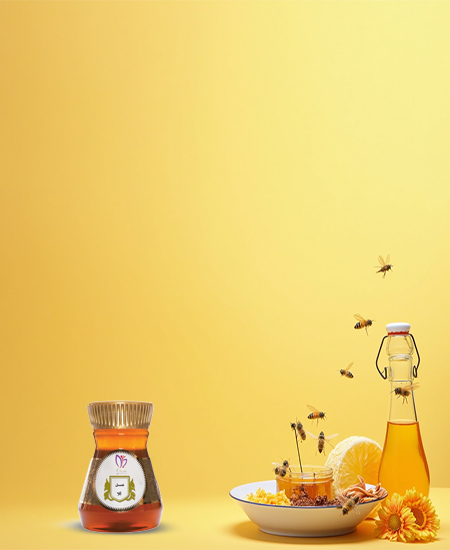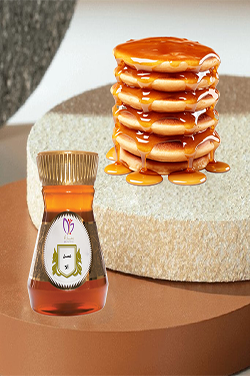Lorem Ipsum is a scrambled text generated simply and nonsensically, originating from the printing industry and used by graphic designers. Printers and texts, as well as newspapers and magazines, are arranged in columns and rows as needed. For the current technological conditions, this is required and serves diverse applications with the aim of improving practical tools.
To produce one kilogram of this delightful nectar, a bee is compelled to transport nectar 120,000 to 150,000 times. To accomplish this, it visits ten million flowers and collects nectar (honeydew) while flying a distance equivalent to circling the Earth seven times. Additionally, the movement of a bee’s wings equals 11,400 beats per minute.
In summer, the queen bee lays between 1,000 to 1,500 eggs per day. A bee’s eye lens is hexagonal and surpasses the power of 30,000 optical lenses. The honeybee works faster than an advanced computer. It has a honey sac (fore-stomach) located at the lower part of its abdomen, where it stores the nectar it collects with its proboscis.
The honeybee never sleeps. To concentrate honey, it must reabsorb the nectar it brought to the hive during the day and stored in the honeycomb cells. At night, the bee reabsorbs it again into its honey sac, extracting some water and adding substances such as hormones and enzymes. It then reintroduces it into the cells. Other bees repeat this process, evaporating more water as the air in the hive, created by their wing movements, helps the process. Finally, additional substances such as organic acids and disinfectants are added.
The concentration process continues until the honey reaches its natural density. At this stage, the bees store it inside the cells and seal them with wax. This preserved honey can be stored for a long time.
It is for this reason that honey contains 80 beneficial substances for humans, and no other material possesses such electrifying energy. This nutritious substance never spoils.
Entering the new year is always exciting and a great opportunity to reflect on the year we’ve left behind and the new year we are now in. One of the greats
Honey has been used in the treatment of many diseases since ancient times. In ancient Egypt, honey was held in such reverence that, according to evidence, it was also used in temples and tombs of the dead. In the beliefs of the ancient Greeks, it was thought that the gods consumed heavenly foods such as honey. Honey contains vitamins B1, B2, B3, B5, and B6, and it is also rich in calcium, potassium, sodium, manganese, iron, copper, phosphorus, magnesium, and sulfur. The most important property of honey is its antimicrobial nature. Honey contains antioxidants, which is why its consumption is beneficial for heart and vascular health. Honey helps improve skin health and has anti-aging properties. Tasting and gargling honey syrup is very effective in healing mouth ulcers and soothing throat inflammation. Honey is anti-asthmatic. Although honey is very sweet, it is not harmful to teeth and gums; rather, it keeps the gums healthy and whitens the teeth. It cleanses the digestive system and is anti-diarrheal. Research has shown that it has a very beneficial effect on stomach infections caused by Helicobacter pylori. For this reason, it is effective against stomach ulcers and digestive system disorders. It eliminates kidney and bladder stones; for this purpose, honey should be consumed with frankincense.


Crystallization (or sugar crystallization) of natural honey
In temperate climates, most types of natural honey crystallize at normal storage temperatures. This happens because honey is an excessively saturated sugar solution, meaning it contains more sugar than can remain dissolved in the solution. Many consumers still believe that crystallized honey has gone bad or that it is adulterated with added sugar. The crystallization and whitening of natural honey result from the formation of monohydrate glucose crystals, which vary in number, shape, and size depending on the quality and storage conditions. The less water and the higher the glucose content in the honey, the faster the crystallization occurs. Temperature plays an important role here, as crystallization does not occur above 25°C or below 5°C. The ideal temperature for crystallization is around 14°C, but the presence of solid particles (such as pollen grains) accelerates the process. Typically, after shaking, larger and more asymmetric crystals form. During crystallization, water molecules are released, increasing the internal moisture content of the liquid and raising the risk of fermentation. Therefore, honey that has partially crystallized requires lower temperatures for storage. Additionally, the moisture content in honey is one of the factors that determine how quickly or slowly the honey will crystallize. Importantly, non-natural honey, due to its higher sucrose content and the larger, more complex molecular structure, will never crystallize or will crystallize very slowly.








